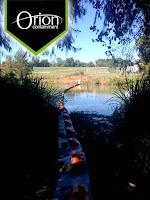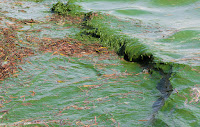Welcome to Part Four of our Aquatic Plant Control blog
series! The topic floating in this week is duckweed.
What is duckweed?
Duckweed is a species of floating aquatic plant and is
extremely small, some species averaging
less than 2 mm in length. While small in size,
duckweed packs a big punch.
Duckweed is often denoted
by its rapid growth and reproduction which is
achieved through asexual budding. In the right conditions colonies of
duckweed double in surface area coverage in just 48 hours! As a result,
duckweed can quickly cover slow moving water bodies in shorter spans of time
than most other species of invasive aquatic plants.
Duckweed is easily
transplanted from one water body to another either through the natural flow of
water or borne aloft on the bodies waterfowl. When birds land in a new lake,
pond, or stream, they carry duckweed with them into a new environment and where
it begins to propagate if conditions allow.
What are the benefits
of duckweed?
Across the world, duckweed is largely a beneficial species
of aquatic plant. In Asia, duckweed is used as a food source due to its
high-protein value and even contains more protein than soybeans! When
cultivated, duckweed is a plentiful food source for humans and waterfowl (hence
the name “duck” weed) and offers habitats
for various other types of aquatic life. Additionally, duckweed can be used to absorb nitrates and phosphates, and the plant also decreases the
evaporation speed of water in drought-prone regions.
Despite the benefits of duckweed, it is an invasive aquatic
weed. Duckweed plants aggressively invade water bodies,
and if uncontrolled, they quickly become a problem as the duckweed covers the
entire surface area of a water body. As the
duckweed blocks sunlight from reaching the floor of the water bodies, native
species of aquatic plants die off, reducing the oxygen dissolved in the water.
Fish and wildlife are harmed or displaced. Duckweed problems are not only
a common backyard pond concern. Many parts
of the world struggle with duckweed control, including Asia, South Africa and
parts of the U.S. including Florida Everglades, parts of Oregon, and many more
regions.
Is there a duckweed
barrier I can use for duckweed control?
Duckweed control, whether to harvest as a food source or to
help contain it to a designated area, can be achieved through the use of an
aquatic plant control boom (also referred to as a duckweed barrier).
Aquatic plant boom serves as an
excellent means of controlling duckweed as it can coral floating plants
into an ideal location for harvesting,
removal, or containment. Learn more about aquatic plant control boom at GEIWorks.com
or contact our team of specialists at 772-646-0597!
Did you miss our last posts in our Aquatic Plant Control
series? Feel free to visit our entries on Blue-Green Algae and Water Hyacinth! Moreover, be sure to come back next time for our final post in our
aquatic plant control series on Sargassum!




.jpg)
.jpg)


